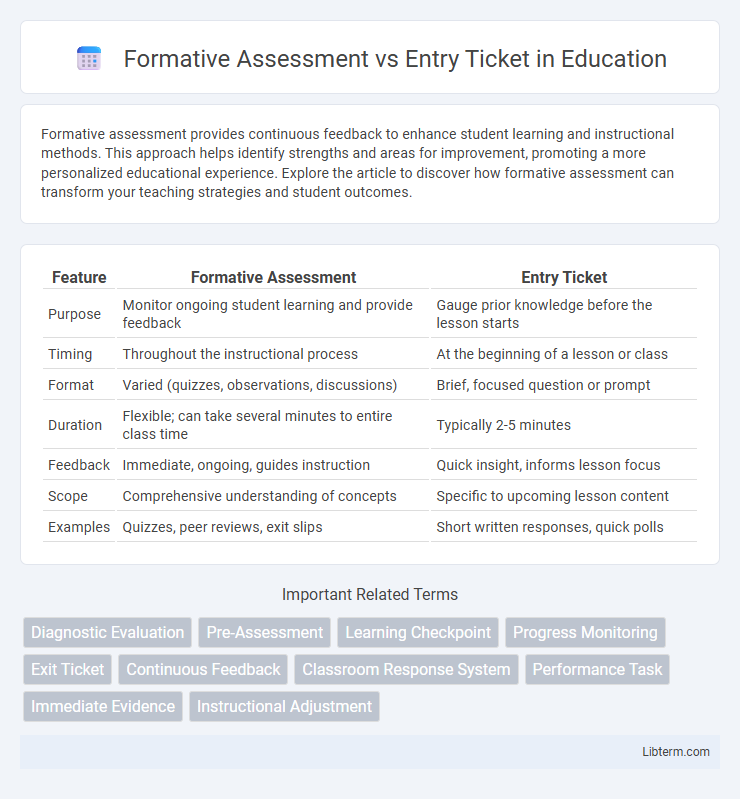Formative assessment provides continuous feedback to enhance student learning and instructional methods. This approach helps identify strengths and areas for improvement, promoting a more personalized educational experience. Explore the article to discover how formative assessment can transform your teaching strategies and student outcomes.
Table of Comparison
| Feature | Formative Assessment | Entry Ticket |
|---|---|---|
| Purpose | Monitor ongoing student learning and provide feedback | Gauge prior knowledge before the lesson starts |
| Timing | Throughout the instructional process | At the beginning of a lesson or class |
| Format | Varied (quizzes, observations, discussions) | Brief, focused question or prompt |
| Duration | Flexible; can take several minutes to entire class time | Typically 2-5 minutes |
| Feedback | Immediate, ongoing, guides instruction | Quick insight, informs lesson focus |
| Scope | Comprehensive understanding of concepts | Specific to upcoming lesson content |
| Examples | Quizzes, peer reviews, exit slips | Short written responses, quick polls |
Understanding Formative Assessment
Formative assessment involves ongoing evaluations that inform both teaching strategies and student learning progress, enabling timely adjustments to improve educational outcomes. Entry tickets are specific, brief tasks used at the beginning of a class to gauge prior knowledge and readiness, serving as one method within the broader formative assessment framework. Understanding formative assessment emphasizes its role in providing continuous, actionable feedback rather than relying solely on summative evaluations.
Defining Entry Tickets
Entry tickets are concise, targeted prompts given at the start of a lesson to quickly gauge students' prior knowledge or readiness on a specific topic. They function as a diagnostic tool distinct from broader formative assessments, which continuously monitor learning progress throughout instruction. By focusing on initial understanding, entry tickets inform immediate instructional adjustments and enhance lesson engagement.
Key Purposes of Formative Assessment
Formative assessment serves the key purpose of providing ongoing feedback to both teachers and students to guide instructional adjustments and improve learning outcomes. Unlike entry tickets, which primarily assess prior knowledge at the start of a lesson, formative assessments encompass diverse strategies such as quizzes, observations, and discussions to monitor student progress continuously. This dynamic feedback loop supports personalized learning and helps identify gaps before summative evaluations.
Objectives Behind Using Entry Tickets
Entry tickets serve as quick, targeted tools to gauge students' prior knowledge and readiness for new content, enabling teachers to tailor lesson objectives effectively. They provide immediate feedback on learning gaps and misconceptions, aligning instructional strategies with specific educational goals. By focusing on student responses at the start of a lesson, entry tickets support formative assessment by informing real-time adjustments to teaching plans and promoting active engagement.
Differences in Implementation
Formative assessment involves ongoing evaluations throughout the learning process to monitor student understanding, using diverse methods like quizzes, observations, and discussions. Entry tickets are specific, brief tasks given at the start of a lesson to gauge prior knowledge or readiness, typically consisting of one or two questions. The key difference in implementation lies in formative assessments being continuous and varied, while entry tickets are concise, targeted tools for initial knowledge checks.
Benefits of Formative Assessment
Formative assessment enhances student learning by providing ongoing feedback that helps identify areas of misunderstanding and tailor instruction accordingly. It promotes active engagement and self-regulation, enabling learners to track their progress and take ownership of their improvement. This continuous process supports deeper comprehension and skill development compared to the one-time diagnostic function of entry tickets.
Advantages of Entry Tickets
Entry tickets provide immediate insights into students' prior knowledge and readiness, enabling teachers to tailor instruction effectively from the start of the lesson. They encourage student engagement by prompting reflection and activating critical thinking before new content is introduced. Compared to broader formative assessments, entry tickets streamline data collection, making it easier to identify learning gaps quickly and adjust teaching strategies in real-time.
When to Use Each Method
Formative assessments are ideal for ongoing evaluation throughout a learning unit to monitor student understanding and adjust instruction, while entry tickets are best used at the beginning of a lesson to quickly gauge prior knowledge or readiness. Formative assessments provide comprehensive feedback over time, supporting deeper learning, whereas entry tickets offer quick insights that inform immediate lesson planning. Choosing the method depends on whether the goal is to guide instruction continuously or to assess initial student comprehension before starting new content.
Challenges and Limitations
Formative assessment often faces challenges such as time constraints, limited teacher training, and difficulty in providing immediate, individualized feedback, which can hinder its effectiveness in real-time learning adjustment. Entry tickets, while useful for quickly gauging prior knowledge, may provide an incomplete or superficial understanding of student readiness and often lack depth in assessing complex skills or misconceptions. Both methods require careful design to avoid inaccurate data interpretation, and their effectiveness depends heavily on consistent implementation and alignment with learning objectives.
Choosing the Right Assessment Tool
Formative assessments provide ongoing insights into student learning and guide instructional adjustments, while entry tickets quickly gauge prior knowledge or readiness at the start of a lesson. Choosing the right tool depends on the objective: use formative assessments for detailed feedback throughout a unit, and entry tickets for brief, targeted checks before new content. Effectively aligning assessment type with learning goals enhances teaching strategies and student outcomes.
Formative Assessment Infographic

 libterm.com
libterm.com